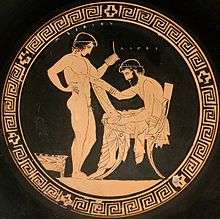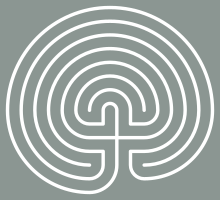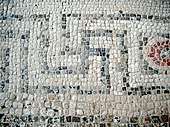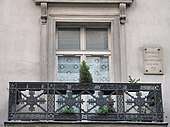Meander (art)
A meander or meandros[1] (Greek: Μαίανδρος) is a decorative border constructed from a continuous line, shaped into a repeated motif. Such a design is also called the Greek fret or Greek key design, although these are modern designations.
%2C_in_Bucharest_(Romania).jpg)

On the one hand, the name "meander" recalls the twisting and turning path of the Maeander River in Asia Minor, and on the other hand, as Karl Kerenyi pointed out, "the meander is the figure of a labyrinth in linear form".[2] Among some Italians, these patterns are known as Greek Lines. Usually the term is used for motifs with straight lines and right angles; the many versions with rounded shapes are called running scrolls.
Meanders are common decorative elements in Greek and Roman art. In ancient Greece they appear in many architectural friezes, and in bands on the pottery of ancient Greece from the Geometric Period onwards. The design is common to the present-day in classicizing architecture. The meander is a fundamental design motif in regions far from a Hellenic orbit: labyrinthine meanders ("thunder" pattern[3]) appear in bands and as infill on Shang bronzes, and many traditional buildings in and around China still bear geometric designs almost identical to meanders. There is a possibility that meanders of Greek origin may have come to China during to the time of the Han Dynasty by way of trade with the Greco-Bactrian Kingdom.
They were among the most important symbols in ancient Greece; and perhaps symbolized infinity and unity; many ancient Greek temples incorporated the sign of the meander. Greek vases, especially during their Geometric Period, were probably the main reason for the widespread use of meanders; alternatively, very ocean-like patterns of waves also appeared in the same format as meanders, which can also be thought of as the guilloche pattern. The shield of Philip II of Macedon, conserved in the museum of Vergina, is decorated with multiple symbols of the meander. Meanders are also prevalent on the pavement mosaics found in Roman villas throughout the Roman empire. A good example is at the Chedworth Roman Villa in England, leading many historians to believe that the pattern was part of the original inspiration for the Latin "G" character.
Meanders and their generalizations are used with increasing frequency in various domains of contemporary art. The painter Yang Liu, for example, has incorporated smooth versions of the traditional Greek Key (also called Sona drawing, Sand drawing, and Kolam) in many of her paintings.[4][5][6]
Gallery
 Geometric bowl decorated with a meander, from 730-720 BC
Geometric bowl decorated with a meander, from 730-720 BC A typical Attic red-figure cup with meander pattern at borders
A typical Attic red-figure cup with meander pattern at borders.jpg) The meander mosaic of the tepidarium
The meander mosaic of the tepidarium A classical labyrinth
A classical labyrinth_-_Foto_Giovanni_Dall'Orto%2C_13-mar-2012.jpg) Roman mosaic in the Archaeological Museum of Milan
Roman mosaic in the Archaeological Museum of Milan Roman mosaic from Chedworth Roman Villa (England)
Roman mosaic from Chedworth Roman Villa (England) Mayan meander from Chichen Itza (Mexico)
Mayan meander from Chichen Itza (Mexico)- Meanders on the façade of a building from Paris, very similar with the ones from Roman mosaics
.jpg) Border pattern from 1800–1830, with meanders in it
Border pattern from 1800–1830, with meanders in it Cast iron balcony decorated with meanders in Paris
Cast iron balcony decorated with meanders in Paris
See also
Notes
- The Greek term maíandros and its Latinized variant meandros are not very common outside of archaeological contexts.
- Kerenyi, Dionysos: archetypal image of indestructible life (Princeton University Press) 1976:89.
- See J. E. L., description of a Late Chou hou at the Boston Museum of Fine Arts, in "A Chinese Bronze", Bulletin of the Museum of Fine Arts 27 (August 1929:48).
- Yang Liu, "Visual art as research: Explorations with sona drawings", Leonardo, April 2010, Vol. 43, No. 2, pp. 129–131.
- Yang Liu, "Cross-culturalism in painting: visualization via meanders", Journal of Visual Arts Practice, Vol. 8, No. 3, 2009, pp. 205–214.
- Yang Liu, "From sona drawings to contemporary art", HYPERSEEING, Summer 2009, pp. 37–41. Published by ISAMA, The International Society for the Arts, Mathematics, and Architecture.
External links
| Wikimedia Commons has media related to Meander. |
- Illustrated Architecture Dictionary: "Fret"—a short description, with a list of links to photographs of meander designs in art and architecture
